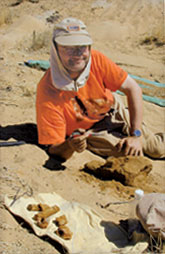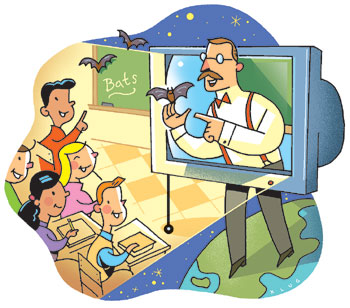Dr.
Hans-Dieter Sues: Dinosaur Hunter
 Dr. Hans-Dieter Sues, Curator of Vertebrate Paleontology,
and the Associate Director for Science and Collections,
is the lead scientist for the development of Carnegie
Museum of Natural History’s Dinosaur Hall expansion.
He has collected dinosaurs and other fossil vertebrates
in many regions of the United States, Canada, China,
Germany, Morocco and Uzbekistan. His research on dinosaurs
and mass extinctions as well as his innovative work
on museum exhibits has been widely featured in the
national and international media. Dr. Hans-Dieter Sues, Curator of Vertebrate Paleontology,
and the Associate Director for Science and Collections,
is the lead scientist for the development of Carnegie
Museum of Natural History’s Dinosaur Hall expansion.
He has collected dinosaurs and other fossil vertebrates
in many regions of the United States, Canada, China,
Germany, Morocco and Uzbekistan. His research on dinosaurs
and mass extinctions as well as his innovative work
on museum exhibits has been widely featured in the
national and international media.
Hans-Dieter Sues digs up a dinosaur bone in Uzbekistan,
September 2002.
This summer Sues
will be in St. Petersburg, Russia, re-searching
the fossil collection of the Zoological
Institute of the Russian Academy of Science, with
his colleague Alexander Averianov. “There are
new species being identified and described regularly,” says
Sues, and in this case he is studying about five new
creatures: “an
early duck-billed dinosaur, a large relative of the
Velociraptor; a large ostrich-mimic dinosaur (like
an ostrich with a long tail), a late descendant of
Diplodocus; and an early true-horned dinosaur,-a
relative of Triceratops.” His goal
is to produce with Averianov a series of scientific
monographs to establish these new species for the
world of science. This is the painstaking analysis
that follows
the fieldwork and the collecting of specimens. Sues
doesn’t only go to places like the Gobi Desert
to do fieldwork. He says sites in Pennsylvania
and the Eastern Atlantic states are potentially
rich,
and reels off the names like York and Lancaster,
Pennsylvania, where he has worked, looking at ledges
of rock, excavating, digging in streambeds. In
York
he was digging in the soil behind a McDonald’s
dumpster when someone challenged him, thinking
he was in search of a good meal. At the Bay of
Fundy in
Nova Scotia he was prying a fossil from beach rock
with his wife when the world’s largest and
most powerful ocean tide started swirling around
his legs.
Sues says he was age four when he knew
he wanted
to be a paleontologist, after seeing wonderful
pictures of past life in a book called Prehistoric
Animals (1961).
He has never deviated, professionally, from that
childhood dream, and has been happily productive
for years in
a profession where a single discovery or scientific
study can redirect the efforts of researchers.
To him the dinosaur is the perfect, “all-purpose
teaching machine” to capture everyone’s
interest in the details of Earth history and
biology.
In his background is a Harvard Ph.D.,
years of fieldwork, and experience with the
world's great
research collections.
Currently he is the President of the Society
of Vertebrate Paleontology, the world’s
premier professional association in the field.
So he knows how the major museums around the
world display dinosaurs. He believes that Dinosaurs
in Their
World, the exhibit
planned for Carnegie Museum of Natural History, “will
be one of the finest dinosaur exhibits anywhere.
It will gain from and build on the experience
that other museums have had in preparing
their
displays.”
Back to Contents
Innovative Program Brings the Museum to Schools
 “Distance
Learning” links
Earth Theater and 500 Sixth Graders “Distance
Learning” links
Earth Theater and 500 Sixth Graders
Illustration
By
Dave Klug
Carnegie Museum of
Natural History is going for the whole package when
it comes to delivering natural history
topics to classrooms. The Division of Education already
has visiting in-school presenters, and a “loan
collection” that
travels to schools and other institutions. Now the
museum has an entire academic standards-based classroom
teaching unit for a two-week experience that includes
video conferencing.
The pilot program in spring 2003
involves over 500 sixth-graders in two different
middle schools, Fox
Chapel in Allegheny County, and College Square in
Beaver County. Its title is the IDEA Program, an acronym
for “Integrated
Distance Education Activity,” and it is supported
by a three-year grant from The Grable Foundation.
“
Biodiversity” is the first topic, but plans
are to add “Dinosaurs” and “Cultural
Diversity” in the future. Each pilot school
gets a full curriculum: 1) a 20-page booklet that
students
use to explore the topic; 2) a visit from a museum
educator (with props) in the class at the start
and end of the project; 3) a live video-conference
from
the Earth Theater to the classroom; and 4) loan
kits to help young people investigate biodiversity.
Diane
Gryzbek, Chair of the Division of Education,
says “The IDEA Program shows how three
internal offerings of the Division can be successfully
integrated:
the In-school Program, the Educational Loan Collection,
and Museum on the Move (which reaches special
needs audiences) to create a program that is
more dynamic
than each stand-alone program.”
Kerry Handron,
Director of the Earth Theater, says this is
the first time she knows of a museum
using
a theater like this to do more than a one-point-of-contact
presentation to a school. A zoo or museum more
typically teleconferences a 45-minute presentation
to a school
on a subject such as “Bats”— but
then it is over. With Earth Theater, a museum
expert in the theater shows up in the classroom
via video
conferencing to answer student questions and
help the already-underway project along. Handron
can add “B-roll” film
(pre-taped short units) to make video conferencing
more complete.
Prior to the video conference,
the teacher will have been working with students “in
the field” to
analyze a 10-meter site outside their school
building, and students will have tried techniques
such as mapping,
using a compass, a bird-song identifier, and
soil corer. At the end of the two weeks, a
museum presenter in
class discusses how the 10-meter study site
is an example of what bio-surveys are like
on a large scale in different
parts of the world.
For more information about
the IDEA Program, or to schedule a program
for 2003-2004, call
412.578.2580,
or email handronk@carnegiemuseums.org.
Back to Contents |